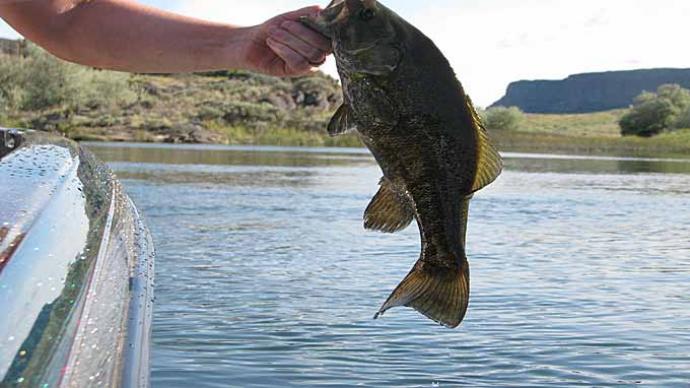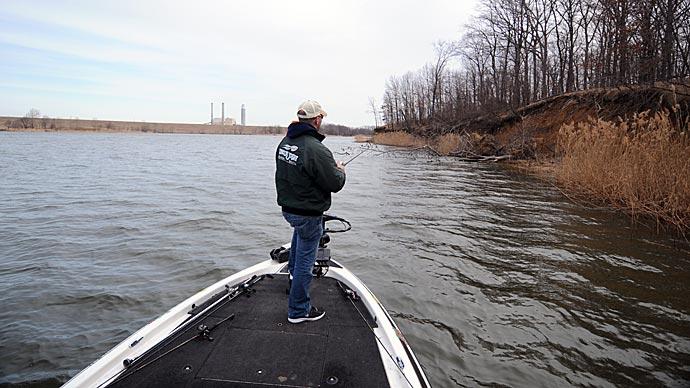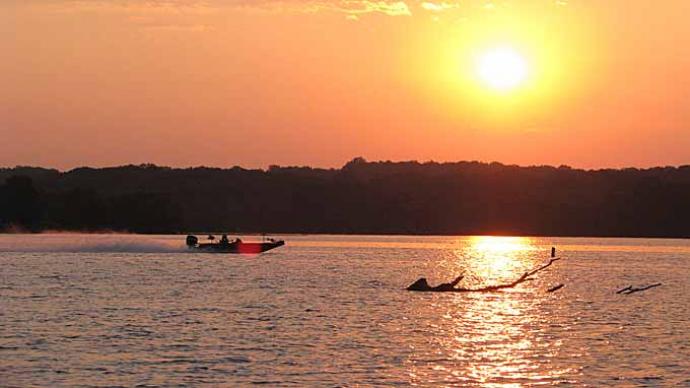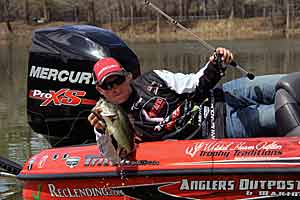
It’s easy to get caught up in the season, especially if you are a bass angler. Most bass in each lake make predictable moves throughout the year, such as shallow to spawn in the spring. Most anglers make the same moves as they work to keep catching bass.
It’s no different in late summer, those dog days of late July and August. During this time, most bass are deep after recovering during post-spawn. They have congregated, in some cases in massive schools, on main-lake structure such as points, humps, and ledges. Many anglers are there, too, setting up camp on these summer haunts.
They are heaving crankbaits with giant lips, Carolina rigs with heavy weights, spoons, and other time-tested deep-water lures. “Most people think about fishing deep,” said Bassmaster Elite Series pro Bradley Roy. But deep is a relative term. He said it might be 12 feet on one lake and 40 feet on another. Regardless, most anglers pound a magic depth range. And by late summer, the bass there feel the effects and are tougher to catch.
Roy looks on either side of that magic depth for late-summer bass. It’s a season of extremes for him and not just the daily high temperature and humidity percentage. He fishes super shallow water or finds bass deeper than others are fishing. Either direction, he heads, he feels he is fishing for the most unmolested bass in the lake.
Fishing shallow
The first late-summer option that Roy has confidence in is fishing shallow. He targets the bass that live in 3 feet or less water all year. There might not be many of them that cruise the banks, but there are enough. He remembers well when fellow competitors fishing shallow beat him in summer tournaments when he was fishing deep. He believes most anglers are so wrapped up in deep fishing this time of year that they forget about shallow bass. That means they feel less fishing pressure and can be easy pickings.
The 2004 Bassmaster Classic on Lake Wyle was a late-summer affair. Before it started, many smart bets were placed on the competitors most comfortable fishing deep water, whether with soft plastics, jigs, or crankbaits. After the final day, Takahiro Omori was crowned champion. He ran up the Catawba River, the main artery for the impoundment on the North and South Carolina line, and flipped and cranked shallow wood. A couple of anglers in the top 10 fished deep, but the rest were beating the bank.
This approach is junk fishing at its finest. “It’s going to be covering water as fast as possible and getting a reaction bite,” Roy said. He throws to laydowns, riprap, docks — whatever he comes across. He might use a buzzbait or popper to cover water in the morning quickly. He’ll switch to pitching plastics as the sun gets higher or crashing a square-bill crankbait through the cover.
Roy looks for specific sections of a lake to fish first. “If I am going to fish shallow, I try to get away from the main lake as much as possible,” he said. Any pressure that bass might feel from deep-water anglers drops the farther he gets away from them. While they might try some shallow fishing, they most likely are unwilling to run as far away from their main spots as Roy is. But he doesn’t head into the back of any creek. He seeks the ones that have the most inflow. “I think the creeks that have a better flow, which refresh with any rain, are the better ones in late summer,” he said. Even a trickle can add color to the water, improve oxygen and add more nutrients. All of those will keep bait and bass in that creek.
Fishing deeper
While less pressure makes shallow bass easy targets, Roy doesn’t give up on those that are deep. He’s not afraid to go out there and rub elbows with other anglers, but he does alter his approach in two ways to overcome the increased fishing pressure. First, he seeks out and fishes the smaller schools of bass that other anglers may have written off. Secondly, he changes up his presentations.
Most of the anglers go to where most of the bass are at any given time. That’s just a fact of fishing life, even in late summer. A prime example is the recent BASSfest on Lake Chickamauga in Tennessee. When the competitors arrived in mid-June, the bass in this Tennessee River impoundment were out of their post-spawn funk and set up on summer patterns — schooled on ledges and points on the main lake. When the current, driven by power generation, moved, so did the bass. And if an angler was lucky enough to be at the right spot at that time, catching one bass could get a whole school going with bites cast after cast.
But there were few of these spots, and several anglers covered most. Seven-time B.A.S.S. Angler of the Year Kevin VanDam, who finished second, shared one deep spot with two competitors — Russ Lane and Jeff Kriet. It was a busy spot, and when Mike Iaconelli tried to join them, VanDam “asked” him to move elsewhere. Those in the community at this hole had to rotate through various lures to keep the bass biting. At times VanDam threw a giant bucktail jig, which is something seldom used, let alone seen, in tournaments. It was evident that the pressure had changed the bass, and these anglers worked to adapt by controlling the amount of pressure and serving up different presentations.
What happened at BASSfest was not a one-time deal. Deep-water spots at lakes across the country are seeing more fishing pressure. “A lot of people are getting good with their electronics,” Roy said. They will stop and fish for them if they idle across a spot and see a large bass school. And so does every other angler who graphs them. Roy finds these schools, too, but when he does, he keeps idling. He wants to tip success more in his favor by finding less pressured bass. Those bass live in small schools that have maybe six to 10 fish. He feels most anglers won’t expend the energy to fish for such a small group. “They’ll see five or six fish on their graph, and they will write that spot off,” he said. These small schools have played vital roles for him at Toledo Bend and Kentucky Lake tournaments.
Larger schools, like the ones VanDam, Lane, and Kriet were fishing on Chickamauga, are known for giving up multiple bass on consecutive casts. Roy will get a bite as soon as he casts into a smaller school, but the action usually stops. “It’s a small community,” Roy said. “They all know what is going on.” It can be tough to keep small schools fired up. So he’ll find five or six of them in practice and then rotate through them during the tournament. He might have to let each school rest for a couple of hours, returning afterward and getting another bite.
Small schools use the same types of structure as large schools, though they might hold just a shade deeper. Roy cut his fishing teeth on Kentucky Lake, a synonym for offshore structure fishing. He said the most popular depth range to fish there is 15 and 24 feet. Anglers seem to lose interest in fishing water deeper than that because he thinks they lack the confidence to explore it. But if he slides just outside their comfort zone, looking in 25 to 30 feet of water, he finds unmolested bass. He has found success making a similar move on other lakes.
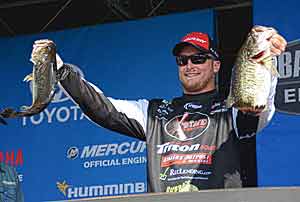
When bass first move to these offshore spots, cranking is in full force. They haven’t seen a big crankbait in almost a year, and they seem to line up to eat them. But as summer heats up and deeper schools swim through daily fishing pressure, that crankbait bite cools. “I end up relying on an old favorite — the Berkley Power Worm,” Roy said. He’ll rig a 10-inch Power Worm on a Texas rig. He also will use a Berkley Havoc Bottom Hopper on a drop-shot rig. “I hate to finesse fish like the next guy, but once it’s late summer, that’s what [the bass] want,” he said. The drop shot stays in the school, rubbing noses with bass till they eat it. He’ll throw the Texas rig on 15- or 17-pound test, but the drop shot, with its lighter line, weight, and hook, softens his presentation to another level.
Roy doesn’t entirely give up on crankbaits in late summer. He’ll still grind them through large and small schools when there is current during the first few hours of the morning or any other low-light period. “If the conditions aren’t perfect, you aren’t going to get bit on a big rattling crankbait,” he said. “They’ve seen a lot of them come by.”
Roy has thrown spoons at deep bass, but not near the size used in the recent FLW Tour stop on Kentucky Lake, which Michigan angler Skip Johnson won with a four-day total weight of 88 pounds and 10 ounces. He didn’t throw them, but several others in the top 10 relied on what are being called magnum spoons, which weigh more than 3 ounces and are close to 10 inches in length. Roy hasn’t had a chance to use them yet, but he regularly fishes smaller spoons — 4 or 5 inches long — for deep bass. But spoons can be tough to use, he said, because their weight, most of which is above the split ring that attaches the hook, creates a pivot point, which makes lipping bass harder and throwing the hook easier. The magnum spoons show what size gizzard shad deep bass are eating. “We don’t give [the bass] enough credit for what they can eat,” he said.
Roy primarily fishes for largemouth in the lakes around his hometown of Lancaster, Ky., during late summer, though some spotted bass may appear in the deep schools. Smallmouth, on the other hand, can be tough to catch. He says night fishing is his best local option for them. Late summer can be a great time to catch smallmouth in the country's northern half. The St. Lawrence River, Lake Champlain, and St. Clair are excellent places to take advantage of this bite. Smallies are ganging up in schools, and fishing drop shots or tubes along deep shoals and weedlines are productive.
End of summer patterns
Regardless if you follow Roy’s advice to the shallows or deep structure, you’ll find slow and steady fishing. You’ll have to cover water, but the bites will come easier than from the bigger schools that most other anglers are targeting. That’s until most of the bass transition into their fall patterns.
Roy said that these late-summer patterns fade when large schools of baitfish arrive in the backs of creeks and main-lake water temperatures begin falling. When this happens, bass go on the move, making more work for him as he tries to stay with them. The only thing that keeps bass in a spot is food. When the food moves, the bass move, too. He likes to fish in the fall because of the comfortable temperatures, especially after a summer of sweating. But autumn isn’t his favorite time to fish a tournament because your success is at the mercy of on-the-move bass whose destination isn’t predictable.
So after spending the last part of summer going in two directions — picking off shallow bass and small schools of deeper ones — Roy takes a new tact in autumn when he gets the chance. And usually, it’s to his favorite deer hunting spot.


